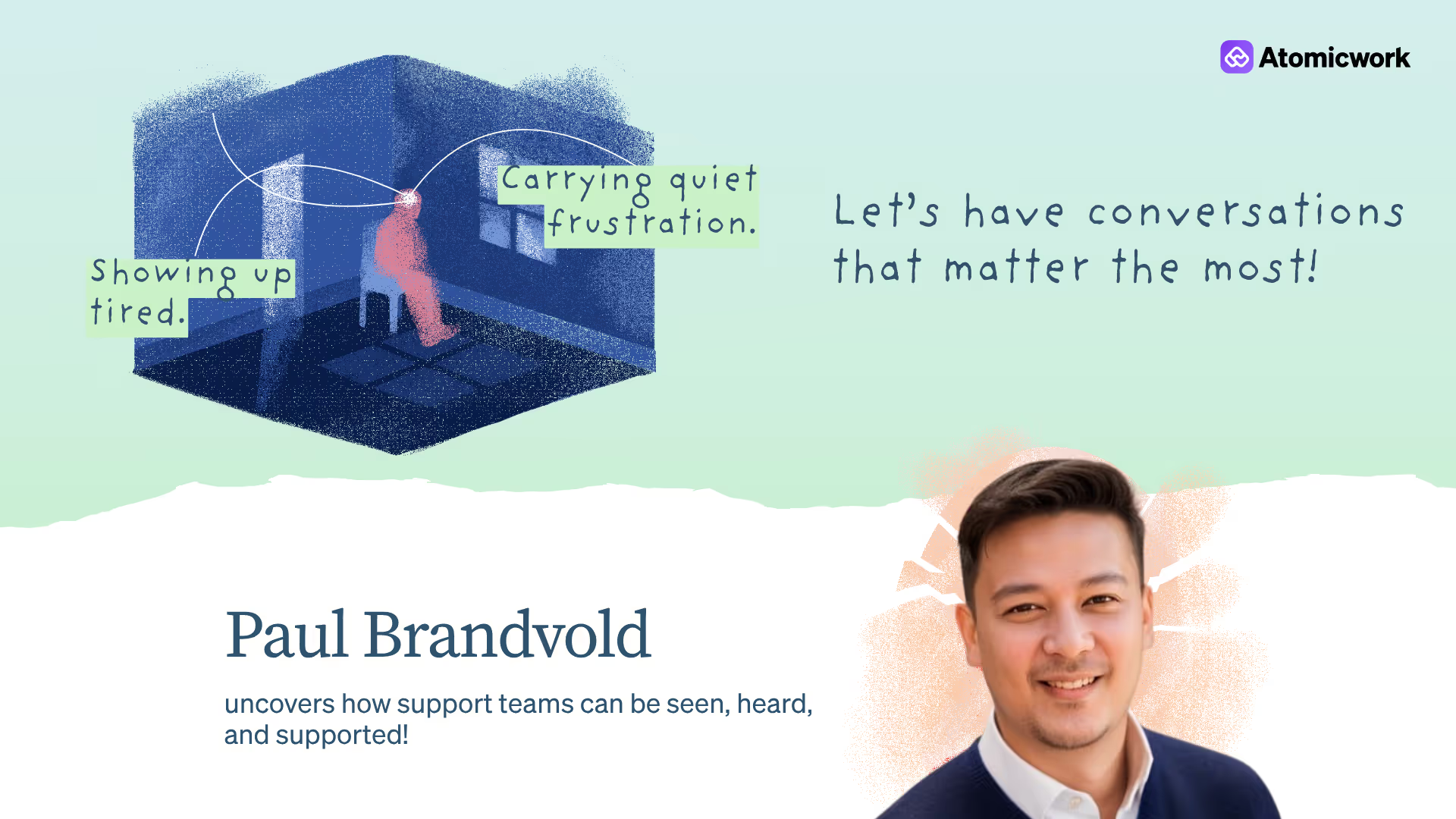The emotional ash of IT: What Paul Brandvold reminded us about support teams

There are no support tickets for burnout. No escalation path for loneliness. No SLA for the quiet emotional toll of fixing the same issue for the hundredth time, with no thanks.
In IT support, so much of the pain is invisible...until someone leaves, someone breaks, or someone finally says what everyone else is thinking: this system is hurting the people who keep it running.
That’s why my recent conversation with Paul Brandvold wasn’t just another webinar. It was a moment of truth.
Paul, an ITIL® 4 Master with years spent inside global support teams, brought forward something we rarely hear in IT circles: a full-throated, soul-deep call to take mental health seriously. Not just with wellness emails or “thank-you” stickers, but with real introspection about how our processes, our tools, and our culture shape the lives of the people behind the screens.
What follows is my reflection—not just on what Paul said, but on what I heard. And more importantly, what I took away from it.
The quiet crisis in IT support
In the realm of IT, heroism is quiet. Success is measured in silence—no alarms, no pings, no fires. But beneath that silence is a crisis we rarely name: emotional exhaustion, institutional invisibility, and the slow fraying of purpose.
“When things go wrong, IT is the first to be called. But when things go right, nobody notices.”
This quote hit me hard. It reminded me of what is celebrated and what is not. And how, over time, that imbalance creates a silent fatigue—the kind that doesn’t show up in burnout metrics until it’s too late.
The myth of efficiency without empathy
Many IT leaders are praised for their operational precision. Low SLAs. Fast MTTR. But as Paul pointed out, those numbers don’t tell the whole story.
“We ask people to follow process, but we never ask how that process affects their sense of self-worth.”
In a system where following process is prioritized over asking why that process exists—or who it burdens—humans become functionaries. Repetitive tasks like password resets or approvals aren't just productivity drains; they're identity eroders.
The failure of wellness theater
It’s easy to post about mental health on LinkedIn in May. It’s harder to confront the systems that actively deplete it the other eleven months of the year.
“Mental health isn’t a Friday yoga session or a Slack emoji—it’s systemic.”
Paul’s words exposed the gap between intention and structure. Between the mental health narratives companies tell, and the cultures they reinforce.
Well-being isn't a one-off workshop. It’s about the architecture of work. Are people respected in escalation protocols? Is their voice heard in retrospectives? Does the tooling reflect compassion, or just control?
The danger of "always-on" culture
Paul also dismantled the harmful myth of the 24/7 IT hero.
“We’ve glorified the idea of being ‘always on.’ But being always available doesn’t mean you’re always okay.”
In IT, responsiveness is a virtue. But when it becomes identity, the consequences are personal: missed family dinners, 2AM tickets, persistent anxiety. These aren’t edge cases—they’re normalized sacrifices.
Safe systems start with conversations
“Creating safe spaces isn’t HR’s job alone, it’s everyone’s responsibility. It starts with one honest conversation.”
That’s what this webinar was for me. One honest conversation. One space to name the things support teams feel but rarely say aloud.
So how do we move from conversation to culture? How do we turn awareness into action?
Actionable ways to create a safe culture in IT
- Normalize vulnerability in team spaces Encourage leaders to model openness. A simple “This week was tough for me, how about you?” in a stand-up can create ripple effects.
- Let support teams speak for the process In retros, ask: “What’s draining you?” or “What process felt unnecessarily painful this week?”—and actually act on the answers.
- Automate the work that erodes morale As Paul noted, repetitive L1 tasks sap energy and joy. Use AI to deflect and resolve these, so teams can engage in work that matters.
- Celebrate invisible wins Don’t wait for crises to recognize effort. Create rituals like weekly shoutouts, dashboards, or even auto-generated kudos, to highlight behind-the-scenes impact.
- Introduce 'emotional health' retros quarterly Beyond sprint metrics, check in on team emotional states. Are people feeling supported? Seen? Is the work sustainable?
- Train every manager to spot silent burnout Make it part of leadership expectations to recognize signs of fatigue, even (and especially) when performance is still high.
What I’m taking away
We often define uptime by the reliability of our systems. But what if we measured it by the resilience of our people?
Paul Brandvold reminded me that behind every support ticket is a human being, trying to stay calm, stay helpful, and stay whole in a system that rarely asks how they’re really doing.
The truth is: you can’t care for your infrastructure if you ignore the ones maintaining it. You can’t automate your way out of apathy. And you can’t build a modern IT organization without building a culture that sees its people—not just when they fail, but especially when they keep things from breaking in the first place.
At Atomicwork, we try to build with care. I think about the person on the other side of the screen.
The goal is simple: the tool shouldn’t get in the way. It shouldn’t add to the frustration. It should actually help.
That’s what I keep coming back to—not just what the platform can do, but how it feels to use when someone’s already having a hard day.
And maybe, just maybe, it starts with asking: “How are you doing, really?” And then doing something meaningful with the answer.
Frequently asked questions

Faq answer paragraph

Faq answer paragraph

Faq answer paragraph

Faq answer paragraph

Faq answer paragraph

Faq answer paragraph

Faq answer paragraph

Faq answer paragraph

Faq answer paragraph

Faq answer paragraph
You may also like...


































